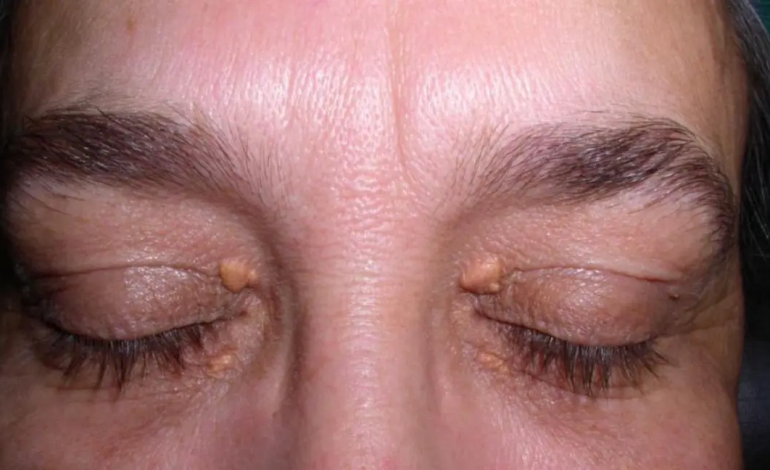
Having great health is important for humans. It enables humans to do many things in life and to have a good life. Getting regular health screening is one of the best ways to ensure a person’s health is at an optimal level. Certain diseases may have been linked with deficiency of certain nutrition, often so lacking from diet. Problems associated with diet mostly are to be blamed for the modern way of living. Thus, what deficiency causes xanthelasma?
Ironically, there are no deficiency that has been concretely linked with xanthelasma. Xanthelasma are yellow growths on or near the eyelids. Xanthelasma is derived from ancient Greece of which “xanthos” means yellow and “elesma” means plate. Xanthelasma near or around the eyelids are also known as xanthelasma palpebrarum. Xanthelasma palpebrarum is the common presentation of xanthoma. Xanthoma is the definition used to describe fat deposited in various areas of the body.
Xanthelasma is often thought to be caused by the high level of fat in blood or those with lipid disorder. About 50% of patients who have xanthelasma have lipid disorder. However, research has shown that apart from the high level of cholesterol, the other half of people who develop xanthelasma have normal cholesterol. Thus, other causes such as inflammation may lead to xanthelasma. For example, those with previous contact dermatitis or previous erythroderma. People who have high chance for developing xanthelasma is those with hyperlipidemia, diabetes mellitus, those with low level of HDL (the good fat), hypothyroidism (low level of thyroid hormones), weight gain, excess drinking alcohol and those used to fatty diet.
Xanthelasma are often seen in those around the middle age or older. Once xanthelasma has developed, it will not spontaneously go away but will remain the same or may be bigger in size. Most people who come to the doctor with xanthelasma often are concerned about their look. Typically, xanthelasma can be seen with soft, yellowish bumps and patches of the inner side of the upper eyelid . It might be solid, semi-solid or firm. The bumps are unlike pimples as they cannot be squeezed.
Since xanthelasma cannot disappear on its own, treatment is needed if people wish to remove it. Xanthelasma is treated by removing the deposit through many ways. This includes cryotherapy (extreme cold or freezing surgery), laser surgery, excision (traditional surgery), extreme heat surgery (electric needle) and chemical peels. The many treatments available can make people confused on which is better for them. Thus, it is best for them to discuss treatment options with a dermatologist or doctor.
Even though treatments are successful in removing xanthelasma, it is worth noting that there is always the possibility of side effects such as scarring and changes in skin colour following the treatment. One of the concerns people might be concerned for is if it can be completely removed for good. Unfortunately, xanthelasma can return after surgery. This is especially true in those with hereditary forms of high cholesterol.
The best way to not get xanthelasma is to take preventative measures. This includes taking steps to manage cholesterol level by practising healthy eating habits, getting regular exercise or physical activity and in some cases, anti-lipid medications. It is also best to drink less alcohol, avoid smoking and quitting whenever possible and to avoid eating food saturated in fats such as fried food or fatty meats. These steps not only help to lower cholesterol level, but if people already get treatment for the condition, it can help prevent xanthelasma from coming back.
Due to the fact that xanthelasma is often caused by the high level of fat or cholesterol in blood, it often associated with signs of heart disease. Xanthelasma may signal to the body that there is indeed a build-up of cholesterol in the blood vessels. This build-up may cause blood flow to the heart to become compromised or even blocked. Eventually, this led to a heart attack. It may even lead to stroke if the deposited fat blocks the blood vessels of the brain.
It can concluded that xanthelasma is not to be caused by deficiency, but more to high levels of cholesterol in the body. Xanthelasma is the most common form of xanthoma. It is often presented as yellow growth on or near the eyelids, and can flat or slightly elevated. The growth itself is harmless. Typically, there are no symptoms apart from the eyelids area. Often, patients get treatment for cosmetic purposes. There are many treatment options available and best to get advice from a dermatologist or doctor before proceeding to any of the treatment. While it is true that xanthelasma is harmless, it is a sign that there is a high level of cholesterol that could indicate a person is at high risk for heart diseases and stroke. The best way to prevent xanthelasma is to live a healthy and active lifestyle.




